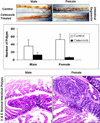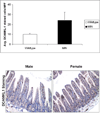Association of stem-like cells in gender-specific chemoprevention against intestinal neoplasia in MIN mouse
- PMID: 21769438
- PMCID: PMC3557947
- DOI: 10.3892/or.2011.1395
Association of stem-like cells in gender-specific chemoprevention against intestinal neoplasia in MIN mouse
Abstract
This study was undertaken to examine the gender-sensitivity and chemopreventive responsiveness of celecoxib on intestinal stem-like cells as a biomarker of colon carcino-genesis, using the MIN mouse model. Male and female MIN mice (6-7-weeks old) were randomized to either control diet or to a diet supplemented with celecoxib (1,500 ppm). The animals were euthanized ten weeks later and the intestines were flushed and opened longitudinally to assess tumor count. Small intestinal segments were formalin-fixed and tissue sections were subjected to immunohistochemical evaluation of DCAMKL1, a known marker of stem-like cells. We found that in animals receiving control (AIN 76A diet) alone, female MIN mice had a higher polyp count than males (52.32 ± 13.89 vs. 35.43 ± 16.05; p<0.0005). However, compared to control diet groups, celecoxib supplementation caused a larger reduction in the number of polyps in females than their male cohorts (6.38 ± 1.43 vs. 12.83 ± 6.74; a reduction of 88% in females to 64% in males). Significant differences (p=0.013) were observed in the number of DCAMKL1-stained cells in the crypts of the wild-type (WT) (10.01 ± 1.07 stem cells per high powered field; HPF) compared to the MIN mice (24.15 ± 8.08 stem cells per HPF), illustrating increased stem-like cells in animals that are more prone to neoplasia. DCAMKL1 labeled stem-like cells were equal in number in the male and female groups receiving the control AIN 76A diet alone (females, 25.73 stem-like cells/HPF); males, 24.15 stem-like cells/HPF). However, females showed a greater reduction in the number of DCAMKL1-labeled stem-like cells with celecoxib supplementation than the respective males (16.63 ± 4.23 vs. 21.56 ± 9.06; a reduction of 35.4% in females to 10.7% in males). We conclude that a higher number of stem-like cells in the uninvolved mucosa paralleled tumorigenesis and mirrored greater chemopreventive responsiveness of female MIN mice compared to males.
Figures



Similar articles
-
Chemoprevention of familial adenomatous polyposis by low doses of atorvastatin and celecoxib given individually and in combination to APCMin mice.Cancer Res. 2006 Jul 15;66(14):7370-7. doi: 10.1158/0008-5472.CAN-05-4619. Cancer Res. 2006. PMID: 16849589
-
Suppression of prostate carcinogenesis by dietary supplementation of celecoxib in transgenic adenocarcinoma of the mouse prostate model.Cancer Res. 2004 May 1;64(9):3334-43. doi: 10.1158/0008-5472.can-03-2422. Cancer Res. 2004. PMID: 15126378
-
Evaluation of 5-aminosalicylic acid (5-ASA) for cancer chemoprevention: lack of efficacy against nascent adenomatous polyps in the Apc(Min) mouse.Clin Cancer Res. 1999 Apr;5(4):855-63. Clin Cancer Res. 1999. PMID: 10213222
-
Chemoprevention of colon cancer by Korean food plant components.Mutat Res. 2003 Feb-Mar;523-524:99-107. doi: 10.1016/s0027-5107(02)00325-1. Mutat Res. 2003. PMID: 12628507 Review.
-
Vitamin D and the nutritional environment in functions of intestinal stem cells: Implications for tumorigenesis and prevention.J Steroid Biochem Mol Biol. 2020 Apr;198:105556. doi: 10.1016/j.jsbmb.2019.105556. Epub 2019 Nov 26. J Steroid Biochem Mol Biol. 2020. PMID: 31783155 Free PMC article. Review.
Cited by
-
COX-2 Inhibitors Decrease Expression of PD-L1 in Colon Tumors and Increase the Influx of Type I Tumor-infiltrating Lymphocytes.Cancer Prev Res (Phila). 2022 Apr 1;15(4):225-231. doi: 10.1158/1940-6207.CAPR-21-0227. Cancer Prev Res (Phila). 2022. PMID: 34987061 Free PMC article.
References
-
- Jemal A, Siegel R, Xu J, Ward E. Cancer statistics, 2010. CA Cancer J Clin. 2010;60:277–300. - PubMed
-
- Schoenfeld P, Cash B, Flood A, et al. Colonoscopic screening of average-risk women for colorectal neoplasia. N Engl J Med. 2005;352:2061–2068. - PubMed
-
- Bresalier RS. Chemoprevention of colorectal neoplasia: advances and controversies (the COX-2 story) Curr Opin Gastroenterol. 2007;23:44–47. - PubMed
Publication types
MeSH terms
Substances
Grants and funding
LinkOut - more resources
Full Text Sources
Medical

